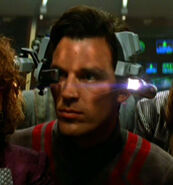
A camera made by Canon
A camera was a device which captured visual data in a way that made it possible for a scene that was captured to be re-created at a later time.
While trying to win some time, Captain Jonathan Archer told Commander Trip Tucker that it was too bad they didn't bring a camera while visiting the Vulcan monastery at P'Jem in June 2151. (ENT: "The Andorian Incident")
Types of cameras[]
Single-frame camera[]

Tucker with a single-frame camera
Single-frame cameras captured one moment from one point in one direction.
In 1986, a man photographed a woman posing next to the Cetacean Institute sign. (Star Trek IV: The Voyage Home)
In 2151, Trip Tucker used such a device to take still images on an unknown planet that was eventually named Archer IV. (ENT: "Strange New World")
He later used one to take a photo of Jonathan Archer in his captain's chair to be sent to an artist in Oakland who was to paint a portrait of the captain that was to be placed in Starfleet Command. (ENT: "Rogue Planet")
Tucker subsequently used a camera to take photos of primitive artwork in some alien ruins on another unnamed planet. At one point, he and Hoshi Sato, who was with Tucker, used the camera in conjunction with a flash unit that Sato held. (ENT: "Vanishing Point")
When the Pakled spy Rumdar came aboard the USS Cerritos in 2381, he used a wrist-mounted camera for taking images during his attempt to gather information about the ship. However, his level of skill with the device seemed to be rudimentary, as he took a photo of his own foot, and was temporarily blinded by a flash from the device. (LD: "The Spy Humongous")
Multi-frame camera[]
Multi-frame cameras, often called video cameras, captured several frames per second and stored them sequentially. The frames were later displayed in sequence, changing at the same frequency that they were captured. These cameras often included audio recording capability as well, synchronizing the sampled audio with the sequence of images.
When the USS Voyager was thrown back in time and space to 1996 Earth, a man caught Voyager in low orbit with his video camera during a barbecue. (VOY: "Future's End")
In 2155, Gannet employed a head-mounted video camera. (ENT: "Demons")
The USS Enterprise's library computer database held schematics of the mid-20th century NASA space probes Nimbus 1 and Ranger 5, which depicted the location of the TV cameras. This database was accessed by the Talosians in 2254. (TOS: "The Cage")
During the mid-23rd century, a wall-mounted camera monitored a cell in which a Harry Mudd android was kept by Orions. (ST: "The Escape Artist")
In 2266, Montgomery Scott installed a television camera device aboard the Enterprise to record the wedding of Angela Martine and Robert Tomlinson. (TOS: "Balance of Terror")
The term "television camera device" comes from the revised final draft script of "Balance of Terror", in which the term was used twice.
On 892-IV, live-action cameras were used to broadcast television programs such as Name the Winner in 2268. (TOS: "Bread and Circuses")
In 2293, three reporters (two males and one female) covering the maiden voyage of the USS Enterprise-B wore head-mounted cameras. Upon Captain Kirk being asked for advice on how to proceed with the voyage when it ran into trouble, the second command he gave was for one of the camera operators to "turn that damned thing off." Each of these cameras had two lenses on either side of the wearer's head and a white, electric light on the left side, between the left-side lens and the user's left ear. The lens on the right side was adjustable but was typically positioned in front of the wearer's right eye. A blinking red light could also be found on the camera's right side. (Star Trek Generations)
In the script of Generations, this type of camera is established as a holographic recorder, otherwise known as a holo-camera. [1]
In 2367, Lieutenant junior grade Anthony Brevelle wore a head-mounted camera during an investigation of missing Starfleet personnel on Tarchannen III. The image data collected was later used to discover an invisible species of alien. This device could be programmed to include data in the recording, like the stardate or the time of recording. It also included a light source that could be switched on if the surroundings were too dark. (TNG: "Identity Crisis")
Holographic camera[]
A holographic camera, also called holo-imager or holo-recorder, took three-dimensional images called holograms.
- See also: Holophotography
Retroactive continuity: A high resolution camera was a piece of advanced sensor technology aboard NASA's Nimbus weather satellites when they were launched in the mid-20th century. The satellite took pictures of weather phenomena on Earth at a distance of 22,300 miles. A diagram of the Nimbus spacecraft in orbit over Earth, in which the high resolution camera was mentioned, was stored in the Enterprise's library computer database. This database was accessed by the Talosians in 2254. (TOS: "The Cage")




